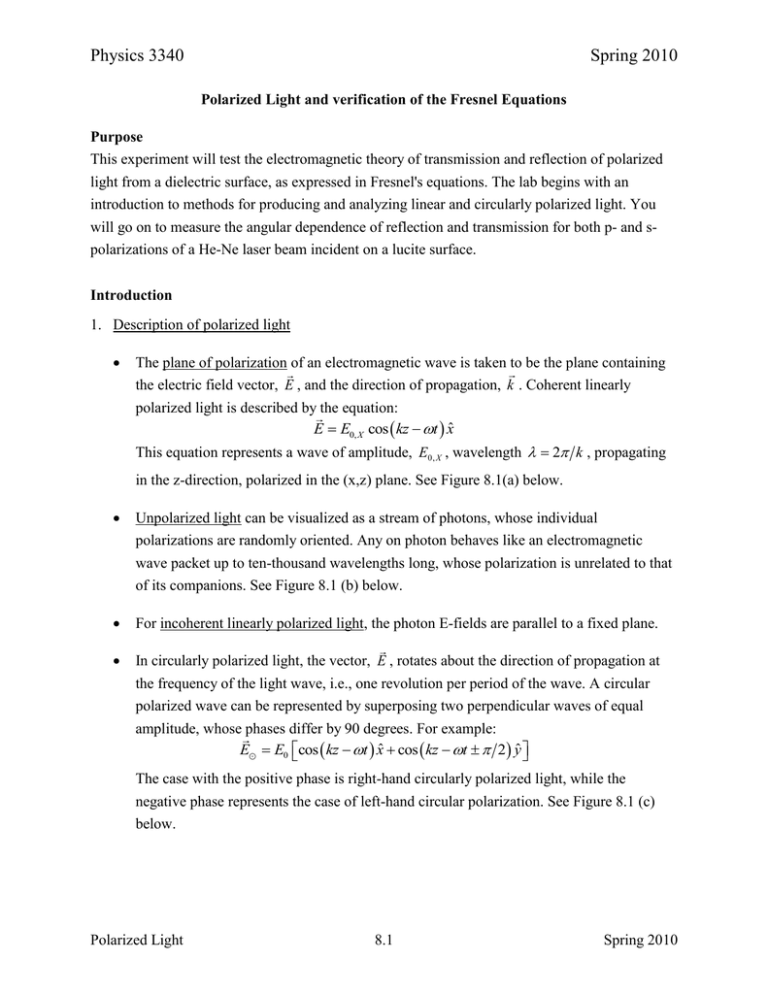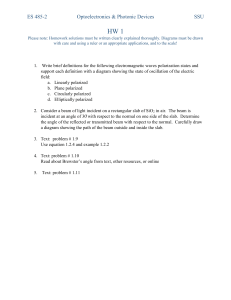Polarization of Light
advertisement

Physics 3340 Spring 2010 Polarized Light and verification of the Fresnel Equations Purpose This experiment will test the electromagnetic theory of transmission and reflection of polarized light from a dielectric surface, as expressed in Fresnel's equations. The lab begins with an introduction to methods for producing and analyzing linear and circularly polarized light. You will go on to measure the angular dependence of reflection and transmission for both p- and spolarizations of a He-Ne laser beam incident on a lucite surface. Introduction 1. Description of polarized light The plane of polarization of an electromagnetic wave is taken to be the plane containing the electric field vector, E , and the direction of propagation, k . Coherent linearly polarized light is described by the equation: E E0, X cos kz t xˆ This equation represents a wave of amplitude, E0, X , wavelength 2 k , propagating in the z-direction, polarized in the (x,z) plane. See Figure 8.1(a) below. Unpolarized light can be visualized as a stream of photons, whose individual polarizations are randomly oriented. Any on photon behaves like an electromagnetic wave packet up to ten-thousand wavelengths long, whose polarization is unrelated to that of its companions. See Figure 8.1 (b) below. For incoherent linearly polarized light, the photon E-fields are parallel to a fixed plane. In circularly polarized light, the vector, E , rotates about the direction of propagation at the frequency of the light wave, i.e., one revolution per period of the wave. A circular polarized wave can be represented by superposing two perpendicular waves of equal amplitude, whose phases differ by 90 degrees. For example: E E0 cos kz t xˆ cos kz t 2 yˆ The case with the positive phase is right-hand circularly polarized light, while the negative phase represents the case of left-hand circular polarization. See Figure 8.1 (c) below. Polarized Light 8.1 Spring 2010 Figure 8.1. (a) Coherent linearly polarized light. (b) Unpolarized light. (c) Right-handed circularly polarized light. 2. Production of polarized light Linear polarization. A linear polarizer, such as polaroid, transmits only that component of the incident E-field that is parallel to the transmission axis of the polarizer. The component of the E-field perpendicular to this axis is either absorbed, or reflected in a different direction. Such a material is known as a dichroic filter. If the emerging light is passed through a second filter, known as the analyzer, only that component of the field parallel to the transmission axis of the analyzer is passed. If the axes of the polarizer and analyzer are at relative angle, , the E-field of radiation emerging from the analyzer is related to that emerging from the polarizer as E2 analyzer E1 polarizer cos . Since light intensity is proportional to the square of the E-field amplitude, we have Malus' Law: I 2 I1 cos 2 In circularly polarized light, the x- and y-amplitudes are equal, but 90 degrees out of phase. The E-vector rotates at the frequency of the light about the direction of propagation. It may be generated by passing linearly polarized light through a quarter wave plate (see Welford, Chapter 4). The quarter wave plate is cut from a birefringent material in which the velocity of light is different according to which of two perpendicular directions the E-field is parallel. The thickness is such that the wave with E in the 'fast' plane gets ahead in phase by 2 (quarter wave) relative to that in the 'slow' plane. The orientation of the quarter wave plate must be such that the 'fast plane' is at 45 degrees relative to the plane of polarization of the incoming light. If the angle is not 45 degrees, then the resulting light is elliptically polarized. Polarized Light 8.2 Spring 2010 Figure 8.2. 3. At the boundary between two dielectrics, the reflected and transmitted intensities depend on whether the E-vector lies parallel (p-polarization) or perpendicular (s-polarization) to the plane of incidence (horizontal plane in this experiment). These ratios can be calculated from the boundary conditions on the E and B-fields at the interface. The results are described by the "Fresnel Equations". The ratios of intensities are given by: sin 2 i t IR R 2 I 0 sin i t tan 2 i t IR R tan 2 i t I0 2 2 IT nt 4sin t cos i cos t T cos i sin 2 i t I 0 ni 4sin 2 t cos 2 i cos t IT nt T 2 2 ni sin i t cos i t cos i I0 (s-pol) (p-pol) where the incident and transmitted angles, i and t are related by Snell's Law: ni sin i nt sin t Note that at Brewster's angle, where i t 2 , we have R 0 . All the reflected light would be s-polarized even for un-polarized incident light. Polarization by reflection is a second important method to produce polarized light. Furthermore, we find T 100% for ppolarized light. Glass windows tilted at the Brewster angle are known as Brewster windows. They are used in producing polarized laser sources. Figure 8.3. s- and p-polarization geometries. Polarized Light 8.3 Spring 2010 Apparatus Figure 8.4. Apparatus to measure transmitted and reflected intensities of polarized light. For the introductory experiments, the laser beam passes through the polarizer (polaroid sheet P1) and the analyzer (polaroid sheet P3). The intermediate position, P2 is either empty or is occupied by a third polariod sheet, a quarter-wave plate, or other sample of material. Each sheet can be rotated in its own plane about the horizontal beam axis, and the angle of the polaroid transmission axes measured relative to the vertical direction. The transmitted beam intensity is measured with a photodiode or observed on a screen. Figure 8.4 (b or c) shows the set up for measuring the transmission and reflection coefficients for polarized light incident on a dielectric surface. The dielectric sample is a polished semicircular slab of lucite (plexiglass) attached with wax to the upper member of a pair of rotation tables. These can rotate independently about a vertical axis through the laser beam. The sample is positioned so that the point of incidence of the laser beam is precisely at the center of the diameter face and lies on the rotation axis of the tables. The photodiode detector is mounted on the lower rotator, so it can move independently. Polarized Light 8.4 Spring 2010 The plane of incidence, containing the incident beam axis and the normal to the dielectric surface, is the horizontal plane in this experiment. The angle of incidence on the plane face is varied by rotating the upper table and is measured by viewing the beam (from above) against the angular graph paper on the table surface. The transmitted ray exits along a radius of the curved face, so it is not bent by refraction. The table can be rotated further, enabling the beam to enter radially through the curved face and exit through the plane face. With the later configuration, you can observe the critical angle, C , and total internal reflection. The beam can be observed either by its glow from scattering inside the lucite, or with a white card. Angles can be measured relative to a piece of circular graph paper (xerox copies in the lab) which is stuck onto the top of the table. Black paper just under the sample makes the beam inside it more visible. The narrow laser beam is linearly polarized by passing through the polaroid polarizer, P1. The polarization of the beam can be set either vertical (to give vector E perpendicular to the plane of incidence) or horizontal (E parallel to the plane of incidence) by rotating P1 about the beam axis. The intensity of incident light, I 0 , reflected light, I R , and transmitted light, I T , is measured with a photodiode. You may need to change the resistor in your present metering circuit to accommodate the different light intensity in this experiment. The photodiode is attached to the lower of the pair of rotation tables, enabling it to be positioned independently in the beam it is to measure. Complete collection of the beam at the photodiode aperture presents a problem. Verify that the total of the reflected and transmitted powers DOES EQUAL the incident power throughout the experiment in order to verify that the collection efficiency remains constant. Polarized Light 8.5 Spring 2010 Problems 1. Polarization problems. a) What is the fraction of light intensity transmitted by the second of two polaroids, whose axis of transmission are 30 degrees apart? b) Suppose that your laser produces light polarized vertically, and you need to make the measurements with horizontally polarized light. Show that this can be accomplished by placing an additional polaroid at 45 degrees between the laser and the final polaroid. What fraction of the laser intensity is incident on the sample? Can you think of another choice of polarizers and wave plates that also solves the problem? 2. Assuming that the refractive index of lucite is n=1.50, calculate the critical angle and Brewster's angle for comparison with your data. Prepare theoretic graphs of the four Fresnel equations. 3. Polarization analysis. a) Devise a procedure to distinguish unambiguously between unpolarized light and circularly polarized light.. b) Find a convincing explanation for the "one-way light valve". See page 8.7. Polarized Light 8.6 Spring 2010 Outline of the Experiment 1. Set up the laser and rotating table on an optic bench. Align the optic axis so that the laser beam passes through the vertical axis of the rotator. 2. Determine whether or not the light from your laser is polarized using the polarization analyzer, P1. 3. Test Malus' law quantitatively using the polarizer (P1) and analyzer (P3). Measure the incident and transmitted beam powers with the photodiode. The intensity of a laser beam may be controlled by inserting two polaroids and adjusting their relative orientation to give the required beam power. 4. Set the polarizer (P1) and analyzer (P3) axes to be mutually perpendicular i.e., crossed. Examine the effect of placing between them the following inserts. a) A third polaroid sheet (P2). Observe how the intensity of light now emerging from the analyzer (P3) changes as you rotate the inserted sheet (P2). b) A quarter-wave plate. Demonstrate that light emerging from the wave-plate is circularly polarized when the fast axis is turned 45 degrees relative to the polarization plane of light from the polarizer. What happens at other angles? c) Show that your polarizer and wave-plate jointly function as a one-way light valve. Try returning the light with a mirror placed beyond P2. d) Try various pieces of plastic and sheet and scotch tape. 5. For the lucite sample: a) Using several angles of incidence between 10 and 60 degrees, determine the refractive index using Snell's Law:. ni sin i nt sin t b) Measure the critical angle and test the relation: sin C 1 n c) Determine the Brewster angle and test the prediction: tan B n d) Measure the intensities of the incident, reflected, and transmitted beams as a function of angle of incidence for both p- and s-polarized light. Plot the reflection and transmission coefficients versus the angle of incidence on the theoretical graphs you produced for Problem 2. Do you confirm the predictions of electromagnetic theory? Verify that the reflected and transmitted powers do sum to the original incident power at each angle, as is required by conservation of energy. Polarized Light 8.7 Spring 2010


